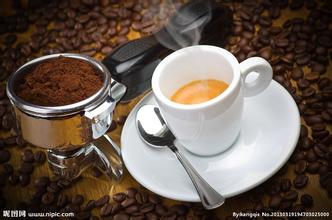Fresh Hawaiian Kona Coffee Flavor and Taste introduction to Hawaiian Coffee
Hawaii's coffee industry has to compete with the expanding tourism industry. Most coffee is grown on the slopes of MaunaLoa. Mauna Loa was originally a volcano located in the western part of the Kona region on the island of Hawaii. The coffee producing area is about 30 kilometers long and its growing areas are mainly concentrated in the north and south of the area. Coffee trees are planted in relatively desolate areas, but their soil is fertile and contains volcanic ash. Although it takes a lot of manual labor to start planting and it is difficult to manage, it is comforting that Kona's coffee trees (at least those growing above 90 meters above sea level) do not seem to be affected by any diseases and insect pests and because of Hawaii's high income level and a large number of tourists, Kona coffee is so expensive that it is even sold as "konablend" (Kona beans contain no more than 5%). In recent years, neighboring islands such as maui, kauai and molokai have also begun to grow coffee commercially, providing the necessary shade for coffee trees. In fact, it is such superior natural conditions that make Arabica coffee in the Kona region produce more coffee than any other plantation in the world, and always maintain high quality, unique growth and climate environment to create a stronger coffee flavor. For example, 560 kilograms of coffee per hectare are produced in Latin America and 2240 kilograms per hectare in Kona.
But to the regret of coffee fans, only about 1400 hectares produce Kona coffee Hawaiian beans although Hawaii is often affected by tornadoes, but the climatic conditions are indeed very suitable for the coffee industry. There is plenty of rain and sunshine, and there is no worry of frost. In addition, there is a strange natural phenomenon called "free shade". On most days, at about 2 o'clock in the afternoon, white clouds appear in the sky
The good quality of Kona coffee should be suitable for the right geographical location and climate. Coffee trees grow on the slopes of volcanoes, and their geographical location ensures the altitude needed for coffee growth; the dark volcanic ash soil provides the necessary minerals for coffee; the climate is very suitable, and the morning sun gently passes through the steamy air. In the afternoon, the mountains will become more humid and foggy, the white clouds surging in the air are the natural umbrellas for coffee trees, and the evening will become sunny and cool. Because of the suitable natural conditions, the average yield of Kona coffee is very high, reaching 2240 kg per hectare, while the yield of coffee per hectare in Latin America is only 600,900 kg per hectare. It is said that Hawaii first planted coffee in 1813. A Spaniard first grows coffee in the Manoa Valley on the island of Oahu, which is today the main campus of the University of Hawaii. In 1825, an English agronomist named John Wilkinson transplanted some coffee from Brazil to grow in the coffee garden of Chief Birch on the island of Oahu. Three years later, an American missionary named Samuel Riveland Rags brought the branches of the coffee tree from Birch Emirates Garden to Kona, a descendant of the Arabica coffee tree that first grew on the Ethiopian plateau. To this day, Kona Coffee still carries on its noble and ancient lineage. Hawaii is the only state in the United States that grows coffee. Coffee is grown on the five main islands of the Hawaiian Islands, namely Oahu, Hawaii, Maui, Kauai and Muroka. Different islands also produce coffee with their own characteristics. Kona coffee is produced in the west and south of the Kona region of Hawaii, spread over the slopes of Horala and Mauna Loa, which is 32 kilometers long and 3.2 kilometers wide.

Important Notice :
前街咖啡 FrontStreet Coffee has moved to new addredd:
FrontStreet Coffee Address: 315,Donghua East Road,GuangZhou
Tel:020 38364473
- Prev

Introduction to the characteristics of Indonesian Sumatra Coffee Flavor Manor
It is said that during the second World War, when the Japanese occupied Indonesia, some Japanese soldiers went to a cafe run by the Mantenin to drink coffee. They thought the coffee provided by the owner was very good, so they asked the owner about the name of the coffee, and the owner mistakenly thought they were asking who they were, so they answered that they were Mantning.
- Next

Introduction of fine coffee with light and pure flavor in Costa Rican coffee manor
Tarrazu in Costa Rica is one of the major coffee producing areas in the world. The coffee produced is light and pure in flavor and pleasant in aroma. Costa Rica, with its fertile volcanic soil and good drainage, is the first country in Central America to grow coffee and bananas for commercial value. Coffee and bananas are the country's main exports. In 1729, coffee was introduced from Cuba to Goth.
Related
- Detailed explanation of Jadeite planting Land in Panamanian Jadeite Manor introduction to the grading system of Jadeite competitive bidding, Red bid, Green bid and Rose Summer
- Story of Coffee planting in Brenka region of Costa Rica Stonehenge Manor anaerobic heavy honey treatment of flavor mouth
- What's on the barrel of Blue Mountain Coffee beans?
- Can American coffee also pull flowers? How to use hot American style to pull out a good-looking pattern?
- Can you make a cold extract with coffee beans? What is the right proportion for cold-extracted coffee formula?
- Indonesian PWN Gold Mandrine Coffee Origin Features Flavor How to Chong? Mandolin coffee is American.
- A brief introduction to the flavor characteristics of Brazilian yellow bourbon coffee beans
- What is the effect of different water quality on the flavor of cold-extracted coffee? What kind of water is best for brewing coffee?
- Why do you think of Rose Summer whenever you mention Panamanian coffee?
- Introduction to the characteristics of authentic blue mountain coffee bean producing areas? What is the CIB Coffee Authority in Jamaica?

